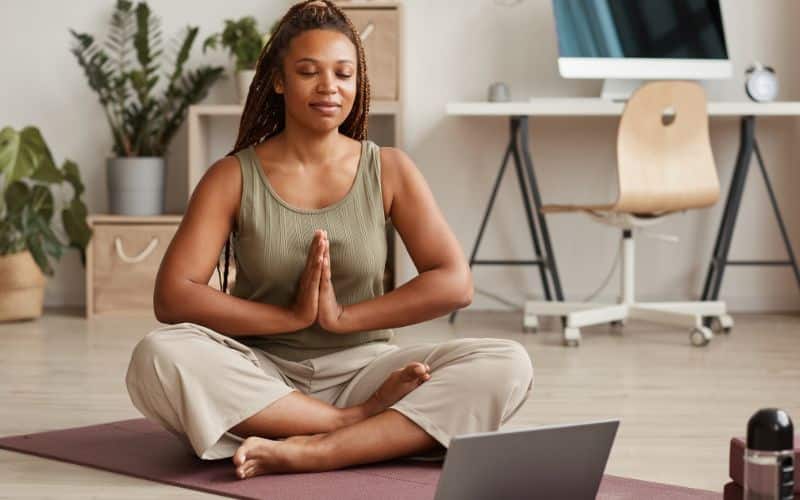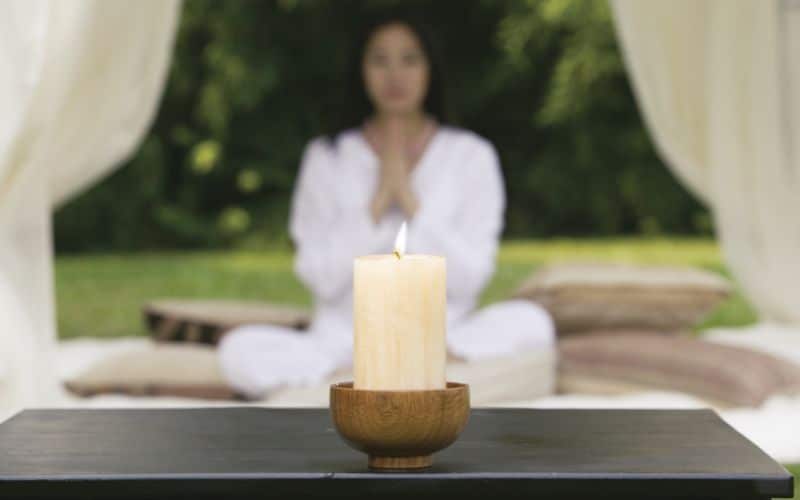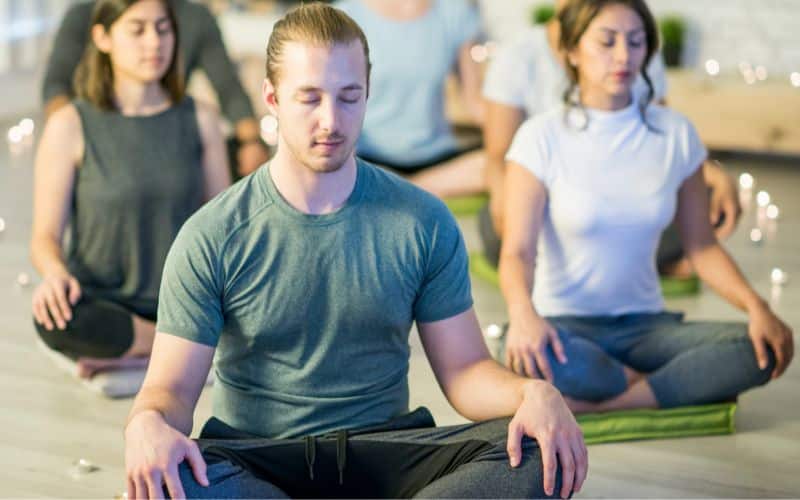Meditation is a simple but powerful practice that can help us feel less stressed, get better sleep, deepen our relationships, improve focus, and help build healthier minds.
Learning meditation for beginners helps you build a greater capacity for love, become more patient, and develop compassion towards yourself and others. If you’re looking to elevate your life and find calm in this chaotic world, meditation is a wonderful place to start.
Browse our beginner guide to meditation and learn the ins and outs of the meditation, explore beginner meditation techniques, and read our best meditation tips for beginners to easily begin your practice.
If you want a quick audio guide, then listen to our 10-minute guided meditation.

Basic Meditation Techniques for Beginners
There are many different meditation techniques suited for beginners. Each style of meditation can help to cultivate self-compassion and build a greater sense of calm and presence in daily life.
Guided meditation
Guided meditation helps to take the guesswork out of meditation. There are many forms of guided meditation. In general, this style offers suggestions of where to place your focus, or reminders to bring your attention back to your breath.
Breath awareness meditation
Breath awareness meditation is a form of mindfulness where you pay attention to the sensations of your breath. It’s a great gateway into mindfulness meditation and can be a quick way to relax.
Body scan meditation
Body scan is a type of mindfulness meditation where you scan through your body and observe the different sensations that arise. You can cultivate certain feelings like gratitude for specific parts of your body, or observe how your body feels.
Loving-kindness meditation
Loving-kindness, or metta meditation, is a meditation that helps to connect with and open your heart. It helps develop compassion, acceptance, and gratitude towards ourselves and other people.
Visualization meditation
Some meditations use visualization or guided imagery to help connect to pleasant states of mind, or sensations. For example, you can visualize yourself in a peaceful place in nature to help cultivate a calm sense of mind.
Walking meditation
You don’t have to sit still to meditate. Walking meditation is a style of moving meditation where we practice mindfulness of our bodies and sensations as we step forward. This meditation technique can be more accessible to beginners since many of us are not used to being still for long periods.

Meditation Guide For Beginners
Meditation might be simple, but that doesn’t mean it’s easy. Today our minds are overstimulated and wired for distraction. Moving in the opposite direction will take practice and patience.
But, building the meditation muscle doesn’t have to take a lot of time. In as little as 5 minutes per day, you start building and strengthening the neural connections that make meditation easier.
As the benefits of a consistent meditation practice stack up it'll be much easier to meditate longer and deepen your practice.
One of the most accessible forms of meditation for beginners is mindfulness of breath, but there are other forms available to you as well. Below you’ll learn how you can start your meditation practice.
1. Choose a quiet and comfortable space to meditate
The easiest way to cut out distractions is to find a quiet spot to meditate. You also want to make sure you feel safe and comfortable in this location. This makes it easier to direct your attention inward, instead of worrying about what’s happening around you.
2. Find the right position
You can meditate sitting, lying down, standing, or even walking. For most beginners, sitting in a comfortable upright posture will be the easiest way to get started.
You can sit in a chair, on the floor, or use a meditation cushion or bench. The important thing is your body is relaxed and comfortable, but still upright, so you don’t drift off during meditation.
3. Decide on a specific time of day to meditate
There is no ideal time of day to meditate. But, it’s important to pick a time you can commit to daily. This helps to build a consistent routine and make meditation a habit, instead of something you have to force yourself to do.
A lot of beginner meditators prefer to meditate first thing in the morning, or as a way to wind down before bed. But any time of day you have a free block of time will work.
4. Use tools and resources for support
Guided meditations, apps, and timers act as a support system for your meditation practice. They can help take the stress out of meditating the right way and can be very helpful for beginners.
Guided meditations will walk you through the meditation process and offer helpful reminders and tips. While meditation apps offer a blend of guided meditations and soothing background music to help you relax.
You can also use meditation timers, so you aren’t worried about meditating too long or too short.
5. Set a timer
If you’re going to be using a timer or guided meditation, then now is the time to start your timer or press play on your guided meditation. Make sure you’re comfortable and begin.
For those not using a timer or guided meditation, then now is the time to place your attention on your breath. Observe your breath with eyes open or closed, while breathing normally.
6. Come back to the present moment
As you’re meditating you’ll notice that your mind has wandered and you’re no longer present during your meditation. This is completely normal. When you notice your focus drift simply come back to your point of focus, whether that’s a guided audio meditation, mantra, or your breath.
The more you practice, you’ll notice your attention drifting, and it’ll become easier to bring your attention back.
7. Close your meditation
When you finish your practice, take some time to appreciate your meditation and acknowledge the benefits you’ve received.
This will help enhance your meditation results and build positive associations with meditation as it becomes a habit.

How Long Should a Beginner Meditate?
As a beginner, you should meditate as long as you feel comfortable. When starting your meditation practice it’s important your early experiences are enjoyable.
This helps to build a positive association with meditation, instead of becoming something you dread or feels like work.
For some people, this might mean limiting your early meditations to 5 to 10 minutes. Over time, you can increase the duration of your meditation sessions.
Useful Resources for Beginners
When getting started with meditation as a beginner it can be helpful to expand your knowledge around mindfulness and meditation.
Explore the following articles to gain more insight into the meditation process, grow your practice, and learn helpful tips for beginners.
Why Practice Meditation?
A lot of people come to meditation as a way to reduce stress. Although that’s a significant benefit, meditation has been shown to improve nearly every aspect of our lives.
With a steady meditation practice, you can expect greater awareness, better concentration, deep sleep, and more fulfilling relationships. The following are some of the biggest benefits of a consistent meditation practice.
Improves your mental health
Practicing meditation helps to stabilize our often chaotic minds. Meditation can help to reduce anxiety, lower stress, and even ease symptoms of depression.
A regular practice can help you step back and gain perspective on your life and reduces ruminative thinking, which can lead to anxiety and depression in the first place.
Not only that, but meditation increases your levels of focus and discipline. When you’re not meditating you’ll be able to think clearly and your memory will improve.
Increases emotional regulation
Meditating goes a long way toward improving your sense of well-being. It helps to develop a greater sense of mindfulness throughout daily life and enhances your emotional awareness and ability to process emotions.
Meditation will improve your resilience to stress and help you return to balance after being thrown off by pain or discomfort.
Greater mindfulness and self-awareness
Some types of meditation can help you build a deeper understanding of yourself and your connection to all things. You’ll also gain awareness of any harmful thought patterns and learn how to direct these thoughts more positively.
Increasing self-awareness also helps us make better decisions and act in more beneficial ways, which further improves our self-image and mental health.
Better physical health
Beyond the cognitive, emotional, and psychological benefits, meditation improves your physical health too. With a regular meditation routine, you’ll notice benefits like better sleep, improved immune system functioning, and lower blood pressure.
Deeper and more authentic relationships
Most relationship turmoil comes from unfulfilled expectations and miscommunication. Meditation helps us become more present and aware of any projections we have running. This awareness of our internal scripts and feelings helps us develop more mindful relationships.
Being aware and present helps develop a genuine ability to love and experience gratitude and compassion for others.
A lot of these meditation benefits arise when we first start meditating, while others develop more over time. That’s one great reason to maintain a regular practice, no matter how small.

Meditation Tips For Beginners To Practice Daily
The true benefits of meditation come to life when you practice meditation daily and it becomes a normal part of your routine.
Here are a few helpful tips you can use to integrate meditation into your life.
Incorporate mindfulness into daily activities and tasks
Mindfulness can be introduced to any aspect of your life by paying close attention.
For example, instead of washing the dishes in a rush to try and get it over with, use this as a time to practice mindfulness. Feel the hot water running over your hands, or the texture of the sponge in your palm. Direct your awareness towards your breath if you notice yourself thinking.
Anytime you find yourself resisting the present moment, see if you can connect with your body or breath.
Use meditation as a tool for managing stress and anxiety
A quick way to relieve feelings of stress and anxiety is by connecting with your breath.
If you can catch yourself, a quick solution is to direct your attention to the breath. Pay attention to the sensations of breathing and try to breathe deeply into your abdomen.
When we’re stressed we tend to take short and shallow breaths, which only increases these feelings of anxiety and stress. By breathing deep and slow, you counteract this and engage your parasympathetic nervous system, which stimulates relaxation.
Start as small as possible
If meditation seems like a huge commitment, then it can become a source of anxiety in our lives. Instead, give yourself permission to meditate as little as possible.
Even two minutes of meditation will help you build the habit over time. Once meditation becomes a regular part of your life, it’s easier to meditate for longer periods.
What To Expect When Meditating As A Beginner
When you’re getting started with meditation it’s easy to bring ideas and expectations about what meditation is to your practice. It’s common to ask yourself, is what I’m feeling normal? Or, am I doing this right?
Meditation is about connecting to the present moment. Instead of being lost in a sea of thought, you ground yourself in the here and now. It gives you a way to relate to your thoughts and feelings in a more caring, compassionate way.
Following are some of the most common challenges for beginner meditators and how to overcome them.
Difficulty focusing during meditation
Solution: When you start to meditate you'll notice how loud and chaotic your mind is. Our minds are conditioned to think and endlessly run stories about the past and future. When we start to meditate we’re experiencing the onslaught of our thoughts for the first time.
So, difficulty focusing is very normal. The key here is to not judge yourself for being distracted.
Gently bring yourself back to your intention, whether that’s your breath, guided audio, bodily sensations, or something else.
Too many distractions and interruptions
Solution: If you have too many distractions and interruptions during your meditation consider choosing a new place to meditate. Just like there’s no perfect time to meditate, there’s also no perfect place.
Experiment with different locations and times of day until you find a location that’s suitable for relaxation. If you’ve been meditating with your eyes open, then close your eyes to cut out visual distractions.
Finally, consider using a guided meditation or a meditation app. These are designed with beginners in mind and help to cut out outside noise that can distract you.
Difficulty staying awake during meditation
Solution: The brain wave states during meditation are similar to those when you’re falling asleep, so drifting off is common. Or, you could be tired, overworked, or stressed and your body simply needs sleep.
If you’re well-rested and falling asleep continues to be an issue, then experiment with different meditation postures and times of the day. You can also do a walking mindfulness meditation since it’s more active than other meditation postures.
Negative thoughts or emotions that arise during meditation
Solution: Once again, this is completely normal. Whether it’s difficult to suppress emotions or challenges you’re currently facing, these emotions or thoughts will bubble up to the surface.
But, just as they arise, they also pass. One solution is to be present with what’s coming up and be curious about it. Where is this feeling in your body? Is it a tightness in your shoulders? A knot in your stomach?
Being open-minded and curious makes these thoughts and emotions less intense and gives us space to explore and process them.

Meditation for Beginners: FAQs
How Can I Teach Myself To Meditate?
The simplest way to teach yourself to meditate is by practicing mindfulness meditation. Simply find a comfortable spot, sit upright with your spine straight, close your eyes, and bring your attention to your breath. If you find yourself distracted, then bring your attention back to your breath.
Is It Okay To Fall Asleep During Meditation?
Falling asleep during meditation is quite common. When learning to meditate you’re balancing relaxation and alertness, so it’s natural to drift in either direction. Over time you’ll learn the subtleties and staying awake will become easier.
What Type Of Meditation Should A Beginner Do?
Mindfulness meditation is a great place for beginners to start. Beginner mindfulness meditation uses the breath as the focal point for your meditation. Plus, it can be done anywhere at any time.
What Should I Do If My Mind Won't Stop Racing During Meditation?
Having your mind wander during meditation can be frustrating, but it’s a natural part of meditating. Noticing yourself lost in thought and bringing your attention back to the focus of your meditation is part of the process.
Your brain also has limited attention resources, so you can quiet your mind by focusing on a single object or sensation. Some common practices include visualization, guided meditation, and mantra meditation.
How Can I Make Meditation A Regular Part Of My Routine?
The simplest way to make meditation a regular part of your routine is to start small and make it a habit. By meditating first thing in the morning you remove distractions and excuses that build up during the day. Some beginners find meditating before bed is helpful as well.
How To Sit For Meditation For Beginners?
The simplest beginner meditation posture is seated in a chair with your back straight and feet flat on the floor. It also helps to sit up straight and tuck your chin down slightly, so your head, neck, and spine are in alignment.
What Is The Best Book On Meditation For Beginners?
Wherever You Go, There You Are by Jon Kabat-Zinn is a classic book on meditation for beginner students. It’s accessible and offers a variety of mindfulness meditation practices you can get started with right away.
Can You Recommend Any Guided Meditations For Beginners?
There are thousands of different guided meditations for beginners available online. Explore our collection of 40 beginner guided meditations that can help reduce stress, conquer boredom, refresh your mind, cultivate joy, and more.
Is It Normal To Experience Discomfort Or Strange Sensations During Meditation?
When we meditate there are many different processes at work. When we sit still and start to focus our attention inward we suddenly become aware of everything that’s happening.
Things like bodily twitches, phantom scratches, hot or cold sensations, or even losing sense of your body altogether are all common.
These feelings can be strange, but they can be a good thing and as we quiet the mind further these sensations can lessen. If you are concerned about any ongoing physical sensations it can be helpful to consult with a licensed medical practitioner.
Conclusion
Learning and practicing meditation for beginners can help reduce stress, improve focus, elevate your sleep quality, and overall improve your quality of life.
Remember, the most important part is to make a commitment and get started. Even 5 minutes a day of breath awareness meditation will put you on the path toward a happier, healthier, and more relaxed life.
Over time, you can expand your practice with different types of meditation and continue to deepen your connection to your mind.



















